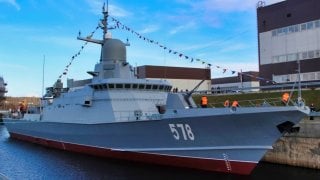This Picture Might Be How the Russian Navy Makes a Comeback
Post-Cold War, the Russian Navy, once boasting significant strength with 467,000 personnel in 1984, experienced a sharp decline in size and capabilities due to reduced defense spending and aging fleet issues. Recent years, however, have seen a strategic pivot towards smaller, more modern warships.
Summary: Post-Cold War, the Russian Navy, once boasting significant strength with 467,000 personnel in 1984, experienced a sharp decline in size and capabilities due to reduced defense spending and aging fleet issues. Recent years, however, have seen a strategic pivot towards smaller, more modern warships.
-This includes the Project 22800 Karakurt-class missile corvettes and Project 22160 patrol ships, designed for coastal and green-water operations. The Karakurt-class, intended to complement littoral zone operations with blue-water capabilities, has four ships currently active, while the patrol-oriented Project 22160 has three in service.
-Despite setbacks, including losses to Ukrainian forces, these vessels represent a critical component of Russia's modernized naval strategy, focusing on flexibility and regional power-projection.
Revamping the Russian Navy: The Shift to Modern Warships
At the end of the Cold War, the Soviet Navy had one of the largest fleets in the world. At its height in 1984, the Soviet naval service had around 467,000 active personnel. By contrast, the modern Russian Navy is significantly smaller. Many of its largest vessels languished as defense expenditures were severely reduced.
One issue was that during the Soviet-era build-up, an emphasis on fleet size came at the expense of support facilities, Meanwhile, many vessels remained in service well beyond their effective lifetimes. After the Soviet Union dissolved, many vessels were then prematurely retired, while funds were only allocated for the completion of ships ordered prior to the Soviet collapse.
Only in recent years has the Kremlin put greater emphasis on smaller, modern warships, and these should not be readily dismissed.
Just this week, Russian state media reported that the Zelenodolsk Shipyard floated out the Project 22800 Karakurt-class small-missile ship Tucha, as well as the Project 22160 patrol ship Viktor Veliky. According to Tass, the Russian Navy operates four Project 22800 and three Project 22160 small warships.
The Project 22800
The Project 22800 Karakurt-class missile corvette was designed by the Almaz Central Marine Design Bureau in St. Petersburg to engage with an enemy's strategic facilities in so-called green waters, including around coastal defenses and offshore installations. It was initially intended as a more seaworthy, blue-water complement to the Russian Navy's Buyan-M-class corvettes that operate in littoral zones.
These corvettes can target hostile surface combatants and take on various threats individually or in conjunction with other forces – even repelling enemy air attacks.
State media stated that the Project 22800 ships have a displacement of 800-900 tons and can maintain a top speed of 30 knots, a cruising capacity of 12 days, and a range of 2500 miles. The vessels are operated by a crew of 39 sailors and officers.
A total of 18 warships from Project 22800 were originally planned for the Russian Navy, but that has been scaled back to 16. Four are now in active service. A fifth, the Askold, was reportedly hit by a Ukrainian cruise missile in November 2023 and damaged beyond repair.
The Project 22160
Designed to guard and protect Russia's maritime economic zone, Project 22160 large patrol ships first joined the Russian navy in December 2018. Displacing 1,300 tons, each vessel has a cruising capacity of 60 days. The ships can reach 30 knots with a range of 6,000 nautical miles.
According to Tass, the warships are armed with one 57mm artillery gun, an anti-aircraft missile complex, and machine guns, while each can carry a Ka-27PS helicopter.
Russian sources claim three are now in service. In March, Ukrainian forces reported sinking the Sergei Kotov while operating in the Black Sea. It was commissioned at the Zaliv Shipyard in late July 2022 and was previously attacked and damaged last September. Another Project 22160 patrol ship, the Pavel Derzhavin, was damaged by a sea drone in October 2023.
The newly debuted patrol ship Viktor Veliky is expected to enter service next year in the Black Sea.
Author Experience and Expertise: Peter Suciu
Peter Suciu is a Michigan-based writer. He has contributed to more than four dozen magazines, newspapers, and websites with over 3,200 published pieces over a twenty-year career in journalism. He regularly writes about military hardware, firearms history, cybersecurity, politics, and international affairs. Peter is also a Contributing Writer for Forbes and Clearance Jobs. You can follow him on Twitter: @PeterSuciu. You can email the author: [email protected].


